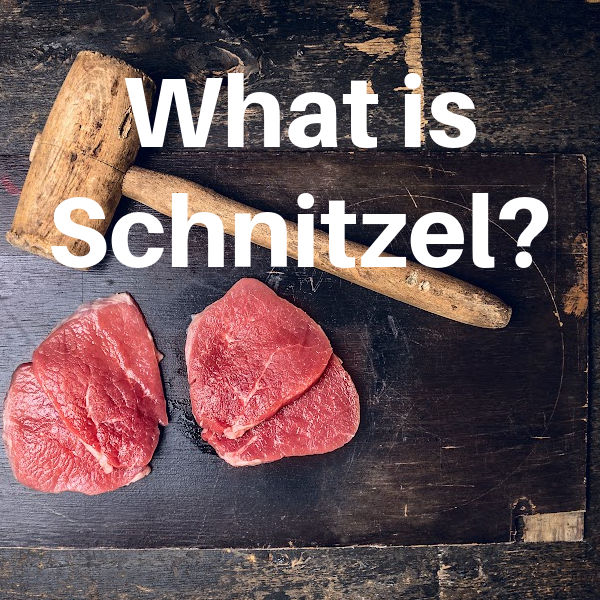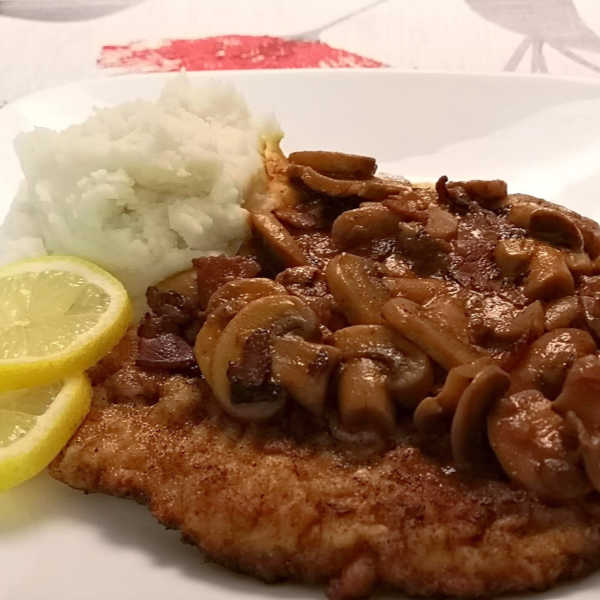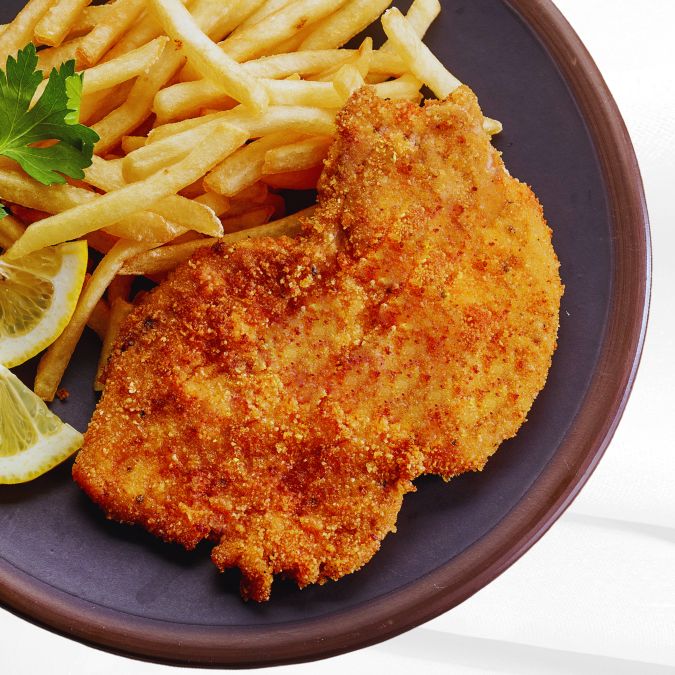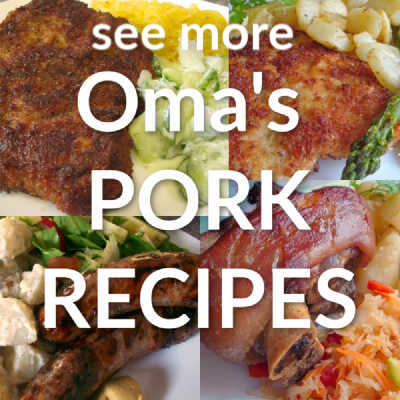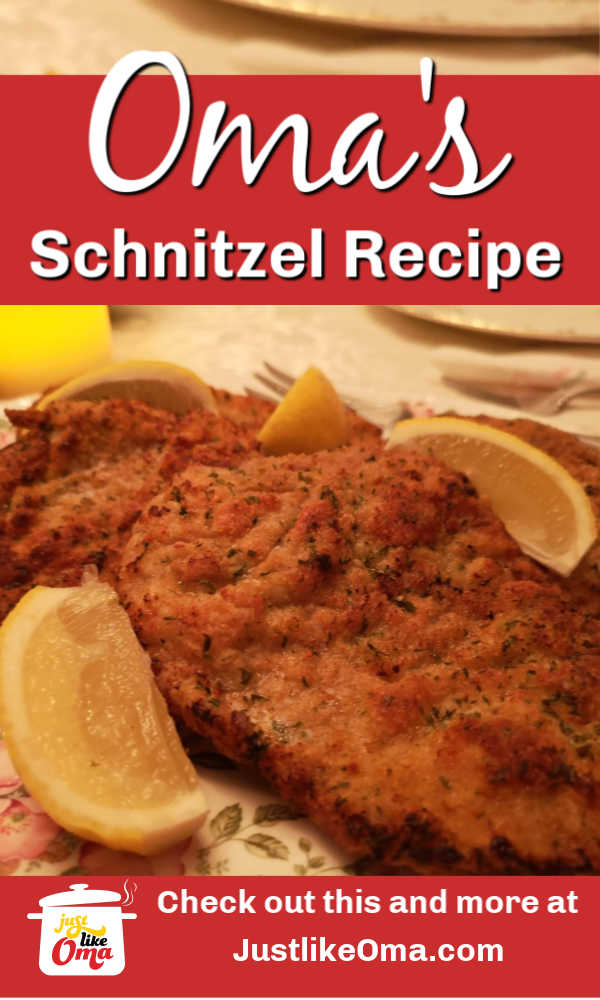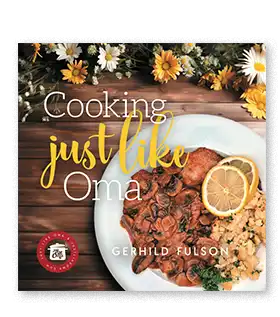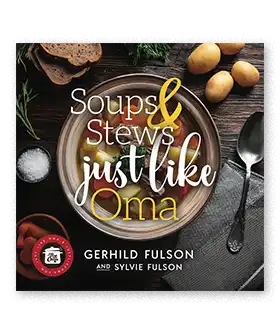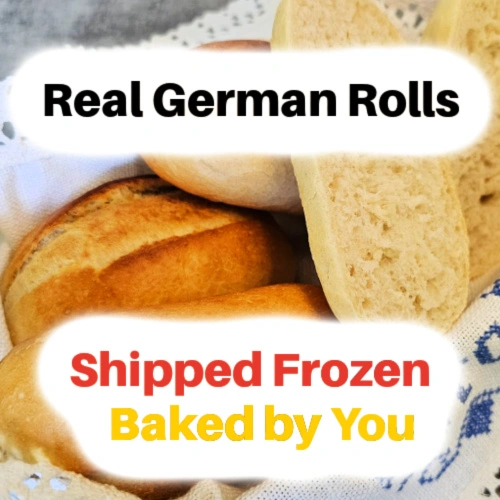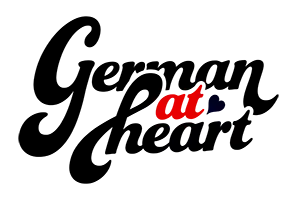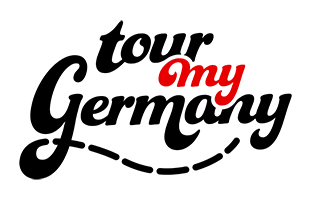Spice up your inbox with FREE German recipes and an exclusive free recipe ebook!
Warm up this winter with Oma's newest cookbooks - available on Amazon >>
Spice up your inbox with FREE German recipes and an exclusive free recipe ebook!
- Home
- German Pork Recipes
- German Schnitzel Recipe
Oma's German Pork Schnitzel (Schweineschnitzel)

by: Gerhild Fulson / Oma Gerhild shares German recipes rooted in family tradition.
Updated: February 15, 2025
German Schnitzel Recipe: Savor crispy, golden perfection with this quick and easy classic that's mega lecker delicious! Supper tonight?
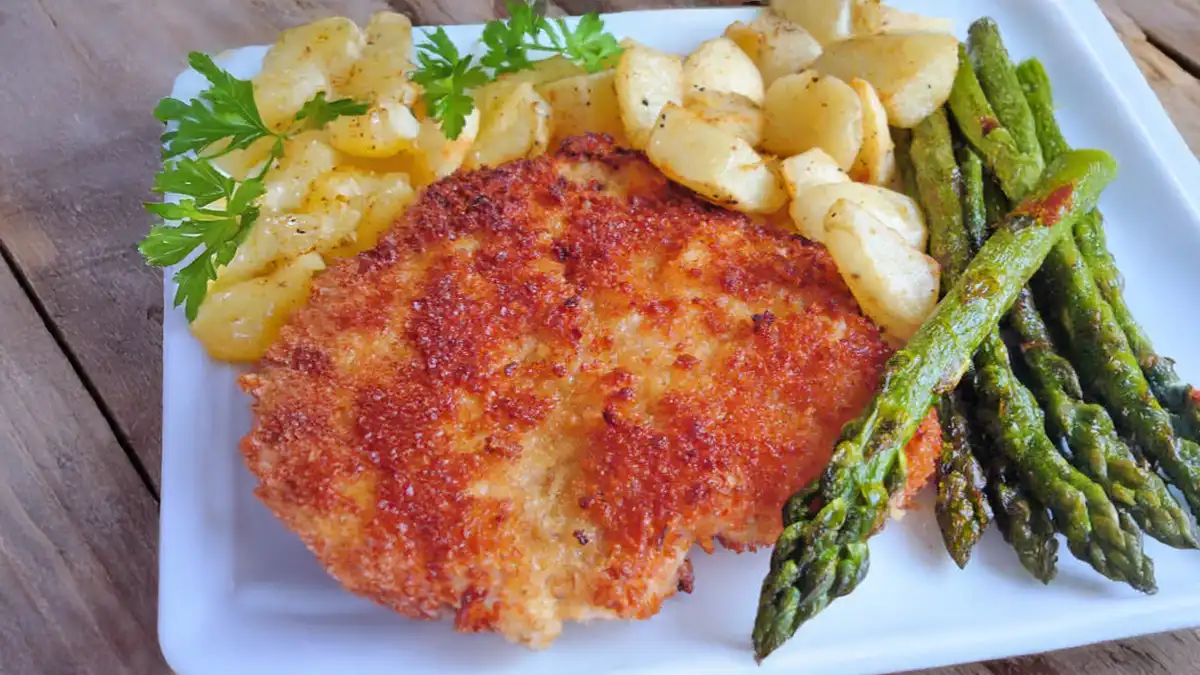 German schnitzel recipe served with roasted asparagus and fried potatoes
German schnitzel recipe served with roasted asparagus and fried potatoesAre you looking for an authentic German schnitzel recipe that's quick and easy? The recipe below is easier to prepare than you might think.
Schnitzel are really just thin cutlets and can be made with just about any kind of meat. You can have veal schnitzel (also known as Wiener schnitzel), pork schnitzel (which is most common in Germany), chicken schnitzel, and turkey schnitzel, among many others. The meat is pounded thin with a meat tenderizer, then breaded, and fried.
Oma’s Recipe Rundown
- Ease of Making: Straightforward; perfect for both beginners and experienced cooks
- Taste: Tender pork with a crispy, golden crust—just like I remember from home
- Time: Ready in about 30 minutes
- Best Served With: Lemon wedges, red cabbage, potato salad, or spätzle
Top Tips For Best Results
- Pound Evenly: Pound the meat evenly to about ¼ inch (0.6 cm) thick for uniform cooking.
- Oil Temperature: Heat oil to 330-350°F (165-175°C). Too hot, and the crust burns; too cool, and it becomes greasy.
- Don't Overcrowd: Fry one or two pieces at a time to maintain oil temperature and ensure even frying.
- Draining: Place cooked schnitzels on a wire rack to keep the crust crisp.
- Gluten-Free Hack: Use gluten-free breadcrumbs and flour
One of the most popular traditional recipes is the German recipe for Jägerschnitzel (Hunter's schnitzel). This is schnitzel served with a most wonderful mushroom sauce.
Jägerschnitzel is sometimes made with un-breaded meat, making it a quicker and easier version than the breaded one.
You choose your fave. My favorite German recipe? Definitely the breaded version. It's German food at its best!
Top 10 Schnitzel Variations In Germany
- Jägerschnitzel (Hunter’s) is topped with a rich mushroom gravy
- Käseschnitzel has cheese melted on top
- Münchner schnitzel is covered with horseradish and/or mustard before coating in flour, egg, and bread crumbs
- Naturschnitzel is un-breaded, served plain or with a simple pan sauce
- Paprikaschnitzel has a tomato sauce with paprika and red peppers
- Rahmschnitzel is topped with a cream sauce, often containing some mushrooms
- Schnitzel Holstein is served with onions, capers, and a fried egg on top
- Vegetarisches schnitzel is meatless and made from soy or tofu
- Weiner schnitzel or Kalbsschnitzel is the traditional breaded veal schnitzel
- Balkanschnitzel (originally called Zigeunerschnitzel) has a sauce containing tomato, bell peppers, and onion slices
What Is Schnitzel?
The definition of schnitzel: a thin slice of meat cutlet, usually tenderized by pounding, coated in flour, eggs, and breadcrumbs, and then pan-fried until perfectly crispy with a deep golden brown crispy breading that covers the tender, juicy meat.
The history of schnitzel spans over 2,000 years and involves the Romans, the Italians, the Austrians, and the Germans.
What Is The Difference Between Schnitzel And Wiener Schnitzel?
The original Wiener schnitzel is thought to have come from Vienna, Austria in the 1600s. It has to be made from veal and is controlled by Austrian law. It is often considered the national dish of Austria!
In Germany, if it's not made with veal cutlet, it must be labelled as coming from pork or chicken, etc. That means, you'll have Schweineschnitzel (pork cutlet) or Putenschnitzel (turkey cutlet) on the menu in restaurants.
Above, I've topped the breaded pork schnitzel with mushrooms that I've fried with bacon and onions. A delicious dish!
Turn Boneless Pork Chops Into Schnitzel
(Find the printable recipe with measurements in the recipe card below.)
I use thick, boneless pork chops and turn them into schnitzel. This method also works well with chicken breast. First, I trim off the fat that's usually around the outer edge. Make sure you take off any silver skin that may also be along the edge.
If this fat isn't removed, it will cause the schnitzel to curl when it is frying.
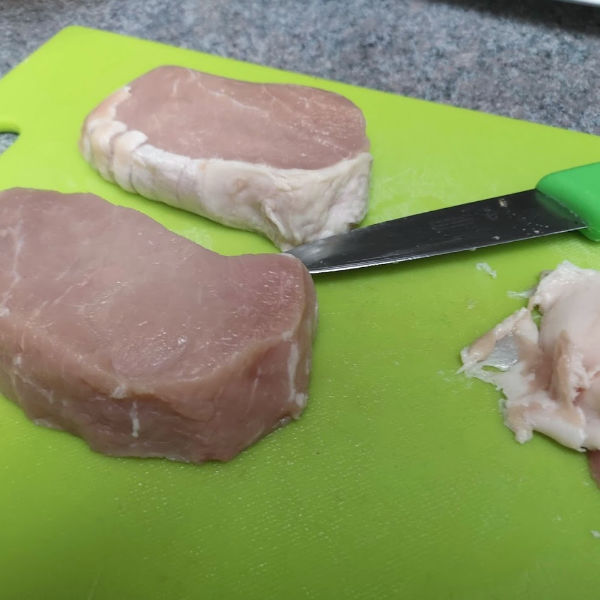 First things first, trim the fat off the pork chops
First things first, trim the fat off the pork chopsButterfly the pork chop: use a very sharp knife and cut the pork chop in half, almost all the way through.
If you cut starting on the rounded side edge, you'll have the longer straight edge as the butterfly back.
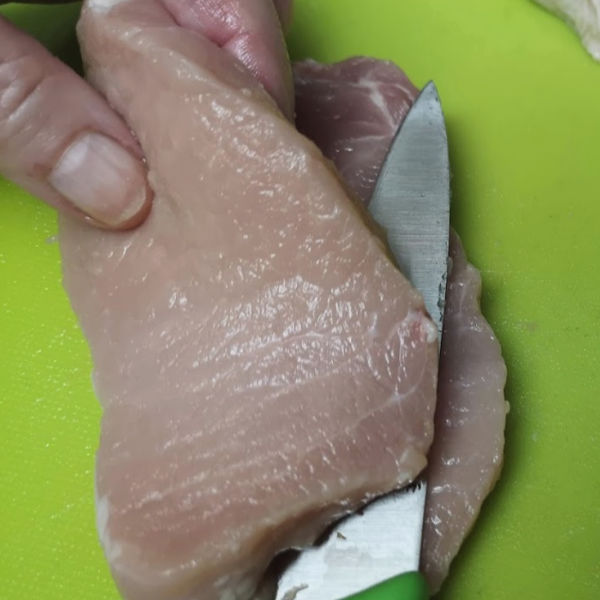 This step shows how to carefully butterfly the pork chop. An important step in making pork schnitzel.
This step shows how to carefully butterfly the pork chop. An important step in making pork schnitzel.When you are almost all the way through, open the pork chop (like a book). You should be able to lie it flat. The middle part should be as thick as the rest of the pork chop.
If the middle is much thicker, cut it just a bit more. Flatten the meat.
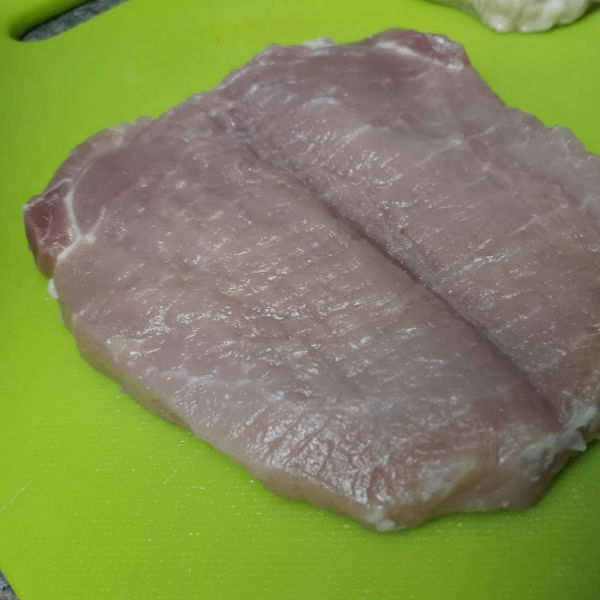 Here is an example of what your finished butterflied pork chop should resemble
Here is an example of what your finished butterflied pork chop should resembleCover the meat with some plastic wrap, and using the flat side of a meat mallet, pound the pork chop sort of gently. You do not want the meat to tear.
You want the schnitzel to be no more than ¼-inch thick.
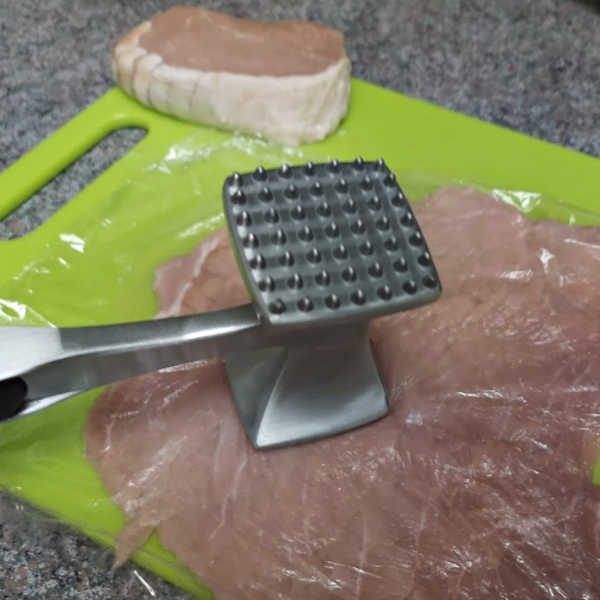 Here, Oma shows how to pound the pork chop so that it is nice and thin
Here, Oma shows how to pound the pork chop so that it is nice and thinSet up three shallow dishes. The first has about half a cup flour, the second an egg/water mix, and the third has about 1 cup bread crumbs.
Season the schnitzel with salt and lemon juice, then dredge it into the flour, then the egg, and lastly in the bread crumbs. Repeat this whole process with all the schnitzel.
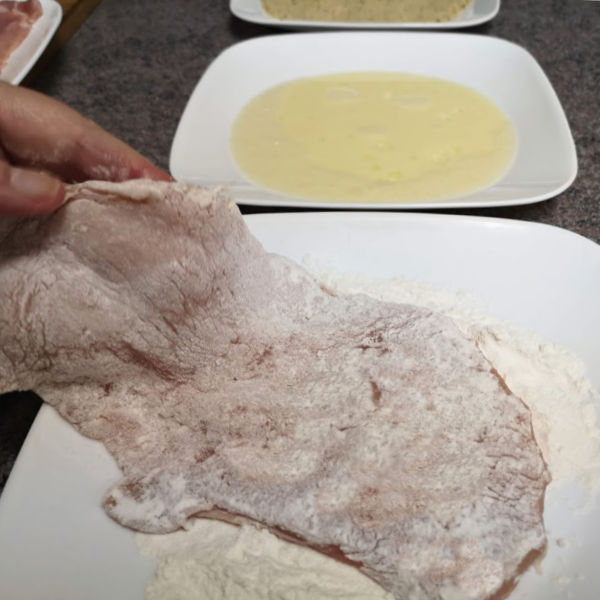 Dredging the schnitzel pork in flour, then egg, then bread crumbs
Dredging the schnitzel pork in flour, then egg, then bread crumbsIn a large frying pan, fry the tender cutlets in 3 tablespoons of butter and 3 tablespoons of cooking oil. Each side only takes a few minutes. Remove to a wire rack on a baking sheet and then keep warm in the oven until the rest have been fried.
Be careful not to crowd them in the pan. You may only be able to fry one at a time, depending on how big your schnitzels are. Mine below is quite big!
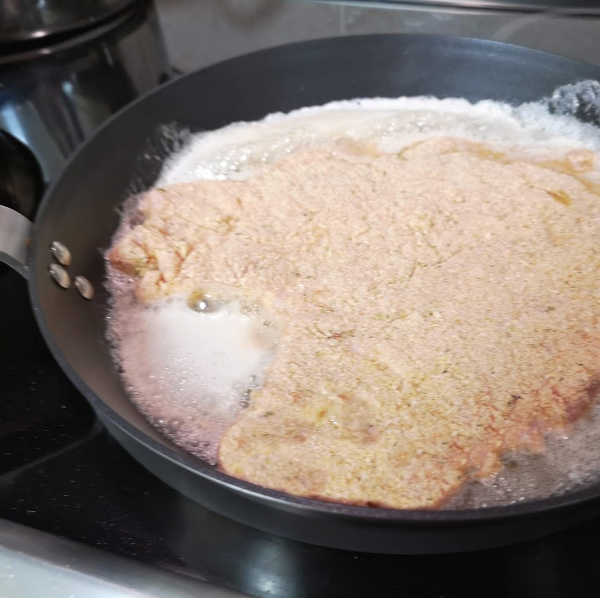 Frying the schnitzel pork in clarified butter or butter/oil mixture
Frying the schnitzel pork in clarified butter or butter/oil mixtureEven though schnitzels aren't deep-fried, they pretty well swim in the fat.
The trick to getting a puffy batter is to splash some of the hot fat onto the sides and top of the schnitzel as it is frying. Don't submerge, though. Just a few splashes.
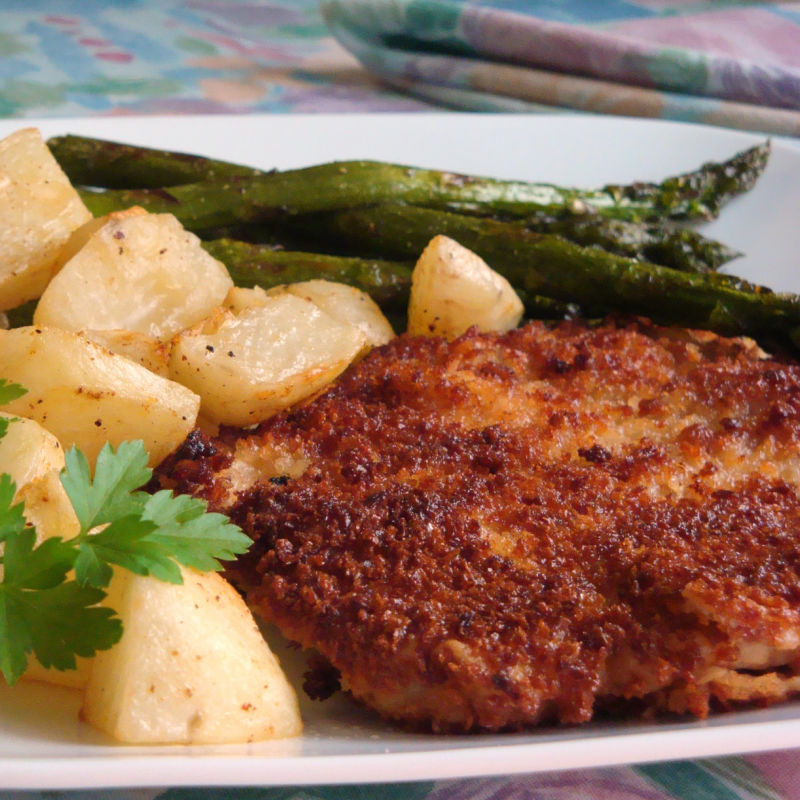 Served! With fried potatoes and roasted asparagus on the side, so delicious!
Served! With fried potatoes and roasted asparagus on the side, so delicious!Oma Says
Have you wondered if you can make schnitzel in an air fryer? Yes, you can. My granddaughter, Lydia, makes these in an Instant Pot Vortex Plus Air Fryer using her easy recipe. She loves trying out the air fryer for German recipes!
Served together with a slice of lemon and her favorite red cabbage as a side dish, this crispy German pork schnitzel recipe would also make a great sandwich on a German bun. So traditionally German.
Planning On Making Jägerschnitzel?
For a classic traditional German meal, serve schnitzel with the most amazing and awesomely creamy mushroom sauce ever! Be sure to make the jäger sauce first and then fry up the schnitzel. This is German comfort food at its best!
The Austrian traditional Weiner schnitzel, when served with sauce, means that the schnitzel is not breaded.
However, in Germany, it's more common to bread the schnitzel. You choose your favorite. There is no right or wrong way to do this. Both are delicious.
What To Serve With Schnitzel
There are SO many ways to serve schnitzel! If you want a traditional German dinner, there are several side dishes that are a MUST! Here are some faves:
- Spätzle: German egg noodles that soak up any gravy.
- Rotkohl (red cabbage) and kartoffelsalat (southern German potato salad) on the side.
- Gurkensalat (cucumber salad) is a refreshing side.
- Bratkartoffeln (fried potatoes) or pomme frites (French fries) with lingonberry jam! Wunderbar!
- Serve in a brötchen (bun).
- Check out these Top 10 side dishes to serve with schnitzel.
Schnitzel, served any which way is just plain WUNDERBAR!
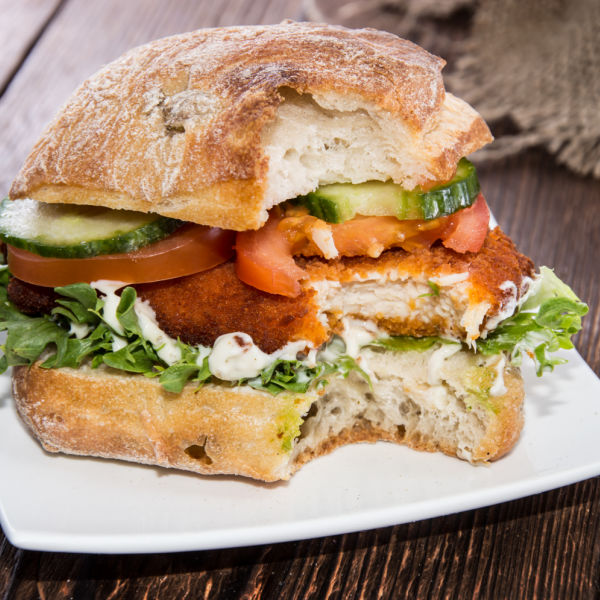 A quick and easy meal: a breaded schnitzel served on a German Brötchen with all the dressings
A quick and easy meal: a breaded schnitzel served on a German Brötchen with all the dressingsHow to Make German Schnitzel Recipe: Oma's Classic Schweineschnitzel
Oma’s simple German schnitzel recipe is a family favorite! Pair it with rich jägersoße for a truly traditional meal. Use veal for Wiener Schnitzel or pork for an easy, delicious alternative!
Prep Time:
15 minutes
Cook Time:
12 minutes
Total Time:
27 minutes
Servings:
4 servings
Ingredients:
- 4 large pork cutlets, about ¼-inch thick or less
- 1 tablespoon (15 milliliter) lemon juice
- ½ teaspoon (3 grams) salt
- about ½ cup (65 grams) all-purpose flour
- 3 tablespoons (45 milliliter) water
- 1 large egg
- about 1 cup (about 150 grams) breadcrumbs
- 3 tablespoons (42 grams) butter
- 3 tablespoons (45 milliliters) peanut or vegetable oil
- 1 lemon, sliced
Instructions:
- Preheat the oven to 160°F (70°C). Place a wire rack on a large baking sheet with. Put a double layer of paper towels on a large plate. Set these aside.
- Place cutlets between plastic wrap and pound gently to achieve uniform thickness if they are thicker than ¼-inch. Sprinkle both sides with lemon juice and salt.
- Place 3 shallow bowls onto the counter. In the first one, put flour. In the second one, mix the egg and water. In the third one, put the breadcrumbs.
- Dredge a cutlet in flour, shaking off excess. Dip into the egg mixture, ensuring full coverage. Press into breadcrumbs, coating evenly. Place onto a large plate and repeat with the remaining cutlets.
- In a large skillet, melt butter and oil over medium heat until shimmering
- Place cutlets in the pan without overcrowding. Fry until golden brown, about 2-3 minutes per side. Depending on the size, you may only be able to fry 1 or 2 at a time.
- Remove the cooked schnitzel very briefly to the paper towel-lined plate to drain any fat, and then place it on the wire rack on the baking sheet in the oven to keep warm.
- Fry the remaining cutlets.
- Serve immediately, garnished with lemon slices or lemon wedges.
Notes/Hints:
- If you are serving this as Jagerschnitzel, you'll want to make the mushroom sauce first and then fry the schnitzel.
- When breading meat, make sure you first pat the meat dry with paper towels so that the flour will stick properly.
- If you want to make this non-breaded, then just dredge in the flour and omit the egg/milk and breadcrumbs.
* * * * *
Unless otherwise noted recipe, images and content © Just like Oma | justlikeoma.com
Recipe Update: February 15, 2025
Schnitzel FAQ
How do I keep my schnitzel from getting soggy?
How do I keep my schnitzel from getting soggy?
Make sure your oil/butter is hot enough (around 330-350 degrees F). Also, don't overcrowd your pan, as it will reduce the oil temperature.
How do I make the crust of my schnitzel crispy?
How do I make the crust of my schnitzel crispy?
When you pat the schnitzel dry, making sure all excess moisture is removed; this will help make it crispy. Then dip it first in flour, then in beaten eggs, then in breadcrumbs for the perfect coating.
Why is my schnitzel tough or chewy?
Why is my schnitzel tough or chewy?
The meat for schnitzel needs to be thin. If the meat is thick, it may result in a tough schnitzel. Pounding the meat thinly and evenly before cooking will solve the issue.
My schnitzel falls apart while cooking.
My schnitzel falls apart while cooking.
Make sure to press the breadcrumbs into the meat to ensure it adheres properly. Remember the flour-egg-breadcrumb sequence to create a strong coating.
What kind of breadcrumbs should I use?
What kind of breadcrumbs should I use?
Dry breadcrumbs are ideal for schnitzel. They create a crispy texture. Some prefer to use Panko breadcrumbs for extra crunch.
Should I use oil or butter for frying my schnitzel?
Should I use oil or butter for frying my schnitzel?
It depends on your preference. Both oil and butter work fine, though butter can burn easily so be careful. You can also use a mix of both, my favorite.
What is the correct temperature for cooking schnitzel?
What is the correct temperature for cooking schnitzel?
The oil/butter temperature should be around 330-350 degrees F. If you don't have a thermometer, insert a wooden spoon in the oil, if bubbles form around it, the oil is hot enough.
What kind of meat should I use for making schnitzel?
What kind of meat should I use for making schnitzel?
Traditionally, schnitzel is made from pork or veal, but you can also use chicken or turkey.
Comments? Questions?
You can leave a comment about this recipe or ask a question...
Pop right over to my private Facebook group, the Kaffeeklatschers. You'll find thousands of German foodies, all eager to help and to talk about all things German, especially these yummy foods.
Meet with us around Oma's virtual table, pull up a chair, grab a coffee and a piece of Apfelstrudel, and enjoy the visit.
Recent Articles
-
German Gingerbread House Recipe: Oma's Traditional Lebkuchen
Nov 13, 25 07:27 AM
German Gingerbread House Recipe: A simple, spiced lebkuchen, honey cake perfect for building and decorating your own festive holiday centerpiece. Fun and delicious for all! -
German Pork Noodle Soup – Oma's Nudelsuppe mit Schweinefleisch Rezept.
Nov 05, 25 09:50 PM
Homemade pork noodle soup ... so easy to make a huge potful to satisfy the hungriest of families or a large party. -
German Marble Pound Cake Recipe – Oma's Marmorkuchen Rezept
Oct 31, 25 08:13 PM
This favorite marble pound cake recipe has been in our family for years. It's a traditional German Marmorkuchen that's easy to make.
Words to the Wise
"The words of the godly are a life-giving fountain; the words of the wicked conceal violent intentions."
Proverbs 10:11 (NLT)
